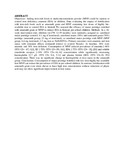Efficacy of amaranth grain flour or multi-micronutrient fortified maize porridge on iron of Kenyan Pre-school Children: A randomized, controlled intervention

View/
Date
2015-08Author
Macharia-Mutie, Catherine
Mwangi, Alice
Brouwer, Inge
Language
enMetadata
Show full item recordAbstract
Objectives: Adding iron-rich foods or multi-micronutrients powder (MNP) could be options to
control iron deficiency anaemia (IDA) in children. Data evaluating the impact of fortification with
iron-rich foods such as amaranth grain and MNP containing low doses of highly bio-available iron
to control IDA is limited. We assessed the efficacy of maize porridge enriched with amaranth grain
or MNP to reduce IDA in Kenyan pre-school children.
Methods: In a 16-week intervention trial, children (n=279; 12-59 months) were randomly assigned
to: unrefined maize porridge (control; 4.1 mg of iron/meal); unrefined maize (30%) and amaranth
grain (70%) porridge (amaranth group; 23 mg of iron/meal); or unrefined maize porridge with MNP
(MNP group; 6.6 mg iron/meal; 2.5 mg iron as NaFeEDTA). Primary outcomes were anaemia and
iron status with treatment effects estimated relative to control.
Results: At baseline, 38% were anaemic and 30% iron deficient. Consumption of MNP reduced
prevalence of anaemia [-46% (95% CI= -67,-12)], ID [-70% (95% CI=-89,-16)], IDA [-75% (95% CI=
-92,-20)] and soluble transferrin receptor [-10% (95% CI=-16,-4)] concentration while significantly
increasing haemoglobin [2.7 g/L (95% CI= 0.4, 5.1)] and plasma ferritin [40% (95% CI=10, 95)]
concentration. There was no significant change in haemoglobin or iron status in the amaranth group.
Conclusions: Consumption of maize porridge fortified with low dose highly bio-available iron MNP
can reduce the prevalence of IDA in pre-school children. In contrast, fortification with amaranth
grain even when shown to have high iron concentration without reduction of phytic acid may not
show significant improvement in iron status.
Citation
Macharia-Mutie, C., Mwangi, A., & Brouwer, I. (2015). Efficacy of Amaranth Grain Flour or Multi-micronutrient Fortified Maize Porridge on Iron of Kenyan Pre-school Children: A Randomized, Controlled Intervention.Publisher
University of Nairobi
